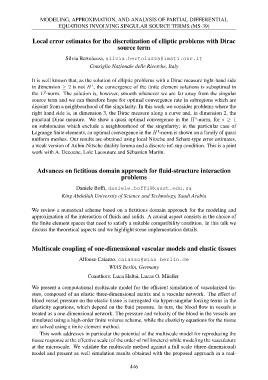Page 448 - 8th European Congress of Mathematics ∙ 20-26 June 2021 ∙ Portorož, Slovenia ∙ Book of Abstracts
P. 448
MODELING, APPROXIMATION, AND ANALYSIS OF PARTIAL DIFFERENTIAL
EQUATIONS INVOLVING SINGULAR SOURCE TERMS (MS-39)
Local error estimates for the discretization of elliptic problems with Dirac
source term
Silvia Bertoluzza, silvia.bertoluzza@imati.cnr.it
Consiglio Nazionale delle Ricerche, Italy
It is well known that, as the solution of elliptic problems with a Dirac measure right-hand side
in dimension ≥ 2 is not H1, the convergence of the finite element solutions is suboptimal in
the L2-norm. The solution is, however, smooth whenever we are far away from the singular
source term and we can therefore hope for optimal convergence rate in subregions which are
disjoint from a neighbourhood of the singularity. In this work we consider problems where the
right hand side is, in dimension 3, the Dirac measure along a curve and, in dimension 2, the
punctual Dirac measure. We show a quasi optimal convergence in the Hs-norm, for s ≥ 1
on subdomains which exclude a neighbourhood of the singularity; in the particular case of
Lagrange finite elements, an optimal convergence in the H1-norm is shown on a family of quasi
uniform meshes. Our results are obtained using local Nitsche and Schatz-type error estimates,
a weak version of Aubin-Nitsche duality lemma and a discrete inf-sup condition. This is a joint
work with A. Decoene, Loïc Lacouture and Sébastien Martin.
Advances on fictitious domain approach for fluid-structure interaction
problems
Daniele Boffi, daniele.boffi@kaust.edu.sa
King Abdullah University of Science and Technology, Saudi Arabia
We review a numerical scheme based on a fictitious domain approach for the modeling and
approximation of the interaction of fluids and solids. A crucial aspect consists in the choice of
the finite element spaces that need to satisfy a suitable compatibility condition. In this talk we
discuss the theoretical aspects and we highlight some implementation details.
Multiscale coupling of one-dimensional vascular models and elastic tissues
Alfonso Caiazzo, caiazzo@wias-berlin.de
WIAS Berlin, Germany
Coauthors: Luca Heltai, Lucas O. Müeller
We present a computational multiscale model for the efficient simulation of vascularized tis-
sues, composed of an elastic three-dimensional matrix and a vascular network. The effect of
blood vessel pressure on the elastic tissue is surrogated via hyper-singular forcing terms in the
elasticity equations, which depend on the fluid pressure. In turn, the blood flow in vessels is
treated as a one-dimensional network. The pressure and velocity of the blood in the vessels are
simulated using a high-order finite volume scheme, while the elasticity equations for the tissue
are solved using a finite element method.
This work addresses in particular the potential of the multiscale model for reproducing the
tissue response at the effective scale (of the order of millimeters) while modeling the vasculature
at the microscale. We validate the multiscale method against a full scale (three-dimensional)
model and present as well simulation results obtained with the proposed approach in a real-
446
EQUATIONS INVOLVING SINGULAR SOURCE TERMS (MS-39)
Local error estimates for the discretization of elliptic problems with Dirac
source term
Silvia Bertoluzza, silvia.bertoluzza@imati.cnr.it
Consiglio Nazionale delle Ricerche, Italy
It is well known that, as the solution of elliptic problems with a Dirac measure right-hand side
in dimension ≥ 2 is not H1, the convergence of the finite element solutions is suboptimal in
the L2-norm. The solution is, however, smooth whenever we are far away from the singular
source term and we can therefore hope for optimal convergence rate in subregions which are
disjoint from a neighbourhood of the singularity. In this work we consider problems where the
right hand side is, in dimension 3, the Dirac measure along a curve and, in dimension 2, the
punctual Dirac measure. We show a quasi optimal convergence in the Hs-norm, for s ≥ 1
on subdomains which exclude a neighbourhood of the singularity; in the particular case of
Lagrange finite elements, an optimal convergence in the H1-norm is shown on a family of quasi
uniform meshes. Our results are obtained using local Nitsche and Schatz-type error estimates,
a weak version of Aubin-Nitsche duality lemma and a discrete inf-sup condition. This is a joint
work with A. Decoene, Loïc Lacouture and Sébastien Martin.
Advances on fictitious domain approach for fluid-structure interaction
problems
Daniele Boffi, daniele.boffi@kaust.edu.sa
King Abdullah University of Science and Technology, Saudi Arabia
We review a numerical scheme based on a fictitious domain approach for the modeling and
approximation of the interaction of fluids and solids. A crucial aspect consists in the choice of
the finite element spaces that need to satisfy a suitable compatibility condition. In this talk we
discuss the theoretical aspects and we highlight some implementation details.
Multiscale coupling of one-dimensional vascular models and elastic tissues
Alfonso Caiazzo, caiazzo@wias-berlin.de
WIAS Berlin, Germany
Coauthors: Luca Heltai, Lucas O. Müeller
We present a computational multiscale model for the efficient simulation of vascularized tis-
sues, composed of an elastic three-dimensional matrix and a vascular network. The effect of
blood vessel pressure on the elastic tissue is surrogated via hyper-singular forcing terms in the
elasticity equations, which depend on the fluid pressure. In turn, the blood flow in vessels is
treated as a one-dimensional network. The pressure and velocity of the blood in the vessels are
simulated using a high-order finite volume scheme, while the elasticity equations for the tissue
are solved using a finite element method.
This work addresses in particular the potential of the multiscale model for reproducing the
tissue response at the effective scale (of the order of millimeters) while modeling the vasculature
at the microscale. We validate the multiscale method against a full scale (three-dimensional)
model and present as well simulation results obtained with the proposed approach in a real-
446


